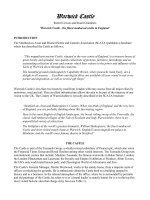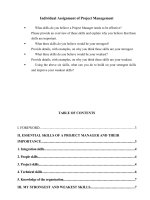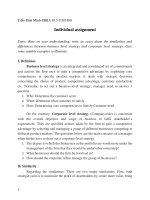individual assignmen
Bạn đang xem bản rút gọn của tài liệu. Xem và tải ngay bản đầy đủ của tài liệu tại đây (3.09 MB, 12 trang )
<span class="text_page_counter">Trang 1</span><div class="page_container" data-page="1">
<b>FPT UNIVERSITY- CAMPUS CAN THO</b>
<b>Email: </b>
</div><span class="text_page_counter">Trang 2</span><div class="page_container" data-page="2"><b>Cần Thơ, 10/2022TABLE OF CONTENTS</b>
2. Need & Problem Identification...6
3. Presention & Demonstration...7
4. Dealing with Objections...8
Listen and do not interrupt...8
Agree and counter...8
Question the objection...8
Hidden objections...9
5. Negotiation...9
6. Closing deal...9
7. Following-up actions...10
</div><span class="text_page_counter">Trang 3</span><div class="page_container" data-page="3"><b>Overview report</b>
In this exercise, I put a lot of emphasis on documenting customer contacts,creating reports, and analyzing in-person client interactions. It provides anintroduction, an analysis of the sales process, a presentation of the resultsobtained, future steps, and suggestions for enhancing the quality of the service.
<b>Selected business</b>
Customers have given Com O 68 restaurant, which is situated at No. 9/9,No. 9, 30/4 Street, Xuan Khanh Ward,Ninh Kieu District, Can Tho City,favorable reviews: 4.5 stars for 85reviews on Google.com and 5 stars for45 reviews on a Facebook fan page.Com O 68 Restaurant is a quaint diningestablishment that focuses mostly onthe refinement of Vietnamese cuisine inthe West.
Customers can taste distinctive, imaginative cuisine with daring traitsand traditions at Com O 68 Restaurant. Special dishes prepared fromingredients are among the most spectacular and notable with the main culinarydesign. Direct service and transportation are the two main service modalitiesoffered by Com O 68. Included a user manual so that customers using the KiotViet application may understand the orders. In addition, the store offers home
</div><span class="text_page_counter">Trang 4</span><div class="page_container" data-page="4">delivery services via City Ship and Eto Ship for the benefit of its consumers.Come to Com O 68 Can Tho to experience the sumptuous flavors just like youwould at home.
<b>II.Selling processApproaching</b>
The service approach's guiding principle need to be the development of themarketing idea. The Com O 68 restaurant and service team must determine theclient's demands and aid the customer in making decisions by helping themchoose from a variety of dishes the flavors that best meet their needs. Theservice interview offers a chance to contrast behavior with particular clientinteraction.
The server at the restaurant fills needs and solves issues by highlighting theexcellent qualities, advantages, and traits that the food possesses. This positionis responsible for learning what clients want to help them decide on satisfactory
</div><span class="text_page_counter">Trang 5</span><div class="page_container" data-page="5">service, assisting customers in determining their needs, providing dishes thatmeet their needs, and describing dishes.
By monitoring how each mid-level employee is able to interpret the buyer'sfeelings. They are able to recognize, comprehend, and react to emotional cuesexpressed through facial expressions. When a customer visits Com O 68, thestaff follows a process that begins with the query "What do you want?.The personnel at Com O 68 all have the essential qualities of a waiter thatclients demand, including competence in dishes, pleasing, and guaranteeing thegreatest customer service. When a customer complains or makes a request thatis unrelated to their primary demands, the restaurant's ability to understand andthe buyer's responsiveness, thoroughness, and aptitude all contribute to thetimely and dependable fulfillment of orders.
<b>1.The opening</b>
A competent service approach that wows clients right away is essentialto ensuring a seamless and effective restaurant business. The service team bowsin greeting customers at the beginning "Hello, sir/madam. How many peopleare you taking with you? Have you reserved a table
in advance? "Make sure there are enough seats,tables, and eating utensils to accommodate thenumber of guests you will be serving. The staff thentakes the lead, invites them to a table, invites themto look at the menu, and gives themrecommendations for some of the items that manyother customers enjoy.
Customers at the Com O 68 restaurant are shownthat wait staff will put in the most time and effort tomeet their needs. Since the crew was confident thatvisitors come to this location to experience andlearn, they opened with the aforementioned inquiry.
Due to this, the wait staff always has a smile on their face, gives guests a warmgreeting, introduces them to the menu, and gives them friendly suggestions fordishes, drinks, etc. In addition, the wait staff is trained in the art of "eyecontact" to establish rapport with patrons.
<b>2. Need & Problem Identification</b>
</div><span class="text_page_counter">Trang 6</span><div class="page_container" data-page="6">To meet the demands and resources of various guests, restaurant staffwill have a variety of foods available. The waiter's first objective is to learnabout the client's issues and requirements. Before serving food, restaurantemployees must comprehend the condition of the customer as well as theirdietary requirements and preferences. They can use one of the restaurant'sofferings to think of solutions to these issues as a result. This needs analysismethod advises restaurant servers to assume a question and listen stance at thebeginning of the service process.
The store allows consumers to place direct orders usingtablets, allowing them to effortlessly select a dish froman illustration and make a note of the dosage theydesire. Employees must, however, use their expertiseand skills to pinpoint requirements and issues when thestore is overcrowded. The restaurant staff at Com O 68employed the Leading question and ALternative kindsto speak to the potential consumer directly or toinfluence their ideas in this case "Would you want totest out the top sellers or the works in progress? areduction? ". They compel a decision from two or moreoptions in order to elicit an answer. Additionally,
information-gathering inquiries like "What kind of cuisine and flavor do youprefer?" are used to obtain information from clients.
They, therefore, employ clarification questions, such as "Do you mean this foodright?" to lessen ambiguity and generalization for precise features. "Apart fromthat, is there another dish you'd want to order?" is used as a transitional phraseto move from one level of the consultation to the next. The restaurant also usesthe same questions for online ordering, however they reverse the inquiries byasking, "What is your address?", "Can you
hold on a second?" and instructing thecustomer to check their phone while the foodis being delivered.
<b>3. Presention & DemonstrationPresentation</b>
The presentation happened naturallyafter the buyer's issues and needs were
</div><span class="text_page_counter">Trang 7</span><div class="page_container" data-page="7">determined. The presentation gives the salesperson the chance to persuade thecustomer once the wants and challenges of the client have been established.The restaurant staff is aware of the foods that customers enjoy after thoroughlydiscussing their preferences. The sales team can respond to various servicingscenarios with the most flexibility thanks to this.
"Is this the kind of cuisine you want to order?" are just a couple of thequestions staff members ask during presentations to make sure theycomprehend the benefits that customers are seeking as well as to see if thecustomer has understood what they have stated. Customers now have thechance to ask questions about anything unclear. The questioning procedureenables restaurant workers to more effectively communicate by adjusting thepace and topic of their presentation to the circumstance.
Because they classify the menu items the restaurant offers,demonstrations lower the risk. If the customer asks for it, the service team willprovide a demonstration. They provide a succinct summary of the flavors andqualities of each meal, making the procedure quick, uncomplicated, precise,and simple to follow. They gave a brief explanation of what needed to be donebefore starting the demonstration: "Our restaurant will serve classic Vietnamesemeals, including... The clients are extremely delighted with..." Theydemonstrate how customers can engage in the "So, what taste can you offer inthe dish?" presentation, demonstrating how each dish's distinctive attributes cansuit customers' wants or provide solutions to their issues. The staff will nexthighlight the dishes that best suit the customer's preferences and explain thespecifications that they have provided.
<b>4. Dealing with Objections</b>
Any issue or query brought up by a consumer is referred to asan ojection. Many comments are just their witness. They want moreinformation because they are interested in the presentation that the wait staff isattempting to make. Issues that are significant to them are highlightedin the objection. For a variety of reasons, this period typically occurs lessfrequently for catering enterprises. However, wait staff at restaurants also makean effort to have the knowledge, counsel, and direction needed to satisfyclients' shopping needs.
</div><span class="text_page_counter">Trang 8</span><div class="page_container" data-page="8"><b>Listen and do not interrupt</b>
Customers are disrespected when they are interrupted, and this mightresult in misconceptions regarding the true nature of the objection. The propercourse of action is to listen intently, respectfully, and with attention. By havinga thorough awareness of the exact nature of the issue, restaurant personnel willbe able to show customers that they are taking the situation seriously.
<b>Agree and counter</b>
This strategy upholds the courtesy that restaurant personnel show topatrons. It will aid in removing concerns and foster an environment ofconsensus rather than disagreement. Customers "Your restaurant's pricing is outof line with other places, and that's an issue." Staff "Yes, the prices of thedishes may look a little pricier than the rivals, but I wanted to demonstrateto you how the service experience at the restaurant won't disappoint."
<b>Question the objection</b>
Sometimes a challenge is too broad and challenging to answer. A patroncan complain that the restaurant's atmosphere is unpleasant or that the cuisine isof poor quality. The waitstaff at the restaurant will inquire about the nature ofthe objection in this case to elucidate the particular problem. Another advantageof challenging concerns is that clients may realize they are overly simplisticafter hearing their exact nature explained to them.
<b>Hidden objections</b>
Not all prospective clients object. Restaurant staff probes veiledobjections to determine their nature. They enquire things like, "Is thereanything you've been thinking about lately?" and "Is there anything you'vebeen unsure about so far?" Being able to properly serve requires being able torecognize potential objections.
</div><span class="text_page_counter">Trang 9</span><div class="page_container" data-page="9">After clients place their orders for the main courses, the waiters would makethem haggle over certain side dishes, saying things like, "This sour soup isgreat when served with braised fish." In many of the particular ways listedbelow, they will guide the customer through the negotiation process.
Staff will ask numerous questions to gather information and ascertain thebuyer's emotions throughout this procedure. In addition, they give the customerauthority, allow for reflection while they wait for a response, and offer anoption to express disagreement. Staff members will refrain from makingcounterproposals, using irritants, watering down your points, or personalizingthe conversation. Buyers, on the other hand, also have a variety of negotiatingstrategies at their disposal. Sellers need to be aware of them since sometimesthey have severe impacts.
<b>7. Following-up actions</b>
The final step is required to make sure that the consumer had a positiveexperience with the service and that there were no issues with delivery, food,space, or quality. The next call can play a crucial part by demonstrating that thewaitstaff truly cares about the customer more than just the customer, which isvital because repeat business is a sign of success for most restaurants. devotedto giving back.
Technology developments have altered how tracking is done. Traditionally, it
</div><span class="text_page_counter">Trang 10</span><div class="page_container" data-page="10">involved a phone call, a letter thanking the client for their business, and aquestion about whether the service met expectations. Nowadays, especially inprofessional settings, Facebook or Google are often used. They efficiently andrapidly reach customers, enabling them to react fast if issues develop.Customers of Com O 68 restaurant can track their level of satisfaction, placemeal orders online, and pay their bills by posting reviews and ratings onaffiliated websites. This procedure accentuates the significance of customizingthe service approach to various customer needs and situations.
<b>III. Recommendations</b>
The utilization of technology to better serve the restaurant—includingreservations, online ordering, owning an ordering system on tablets, andmanaging client feedback—is a standout quality of Com O 68 that should beemphasized. The restaurant also did an excellent job of keeping things cleanand hygienic and providing a variety of payment methods.
Although Com O 68's service and food are generally of high quality, it will bechallenging to attract new and returning consumers at this level. As a result,restaurants need to implement additional recommendations in order to enhancecustomer service and offer a unique experience.
Restaurants might think about sending workers to the required trainingsessions. Restaurant owners are responsible for teaching personnel in a waythat encourages them to focus on making customers happy, such as "Clean upthe dish, take it to the doctor, and check it out." investigated and handlingpromptly timely manner." To guarantee prompt serving as soon as the meal isproduced, all staff members must communicate consistently and effectively.Coordination is made simpler if the work is distributed among all of theparticipants. The order is called in, the ticketing location is assigned, and theorder is delivered to the wait staff by a single individual.
Com O 68 must therefore guarantee the Correct Waiting Time. Time lag canaffect the customer experience. It could be a delay in seating guests, providingmenus, ordering, bringing in meals, or carrying out invoices. Wait times mustbe accurate for top-notch restaurant service. Give clients free bread or a snackwhile they wait to place an order to keep them occupied or inform them of waittimes.
<b>IV. Results achieved</b>
</div><span class="text_page_counter">Trang 11</span><div class="page_container" data-page="11">The effectiveness of the service personnel is crucial to the restaurantindustry's sustainability. A results-driven service team and cutting-edgetechnology are combined by Com O 68 to make it simpler to meet financial andcommunication objectives.
Service professionals continuously concentrate on the most crucial steps in theselling process to achieve significantsuccess, according to experience andstudy. The employees will remain firmin their comprehensive understandingof their product or solution so that theyare able to describe in detail thevariations in flavor and characteristicsof each meal as well as the nutrients itdelivers to the potential consumer andwhy it is the ideal option for them.
The effectiveness of the service personnel is crucial to the restaurant industry'ssustainability. A results-driven service team and cutting-edge technology arecombined by Com O 68 to make it simpler to meet financial andcommunication objectives.
Employees then acquire the knowledge and expertise necessary to automate thesales process, which starts with raising awareness and ends with qualifyingleads being nurtured and bought. Trainers will pick Com O 68 products overthose of their rivals when they exhibit an awareness of their clients' demandsand a well-designed sales strategy to suit those needs.
Additionally, when customers supply details, staff members will comprehendmore of their issues. Consider several approaches and techniques to draw inprospective and devoted clients from there. create and maintain strong ties withcustomers in particular. In the current environment of robust economic growthand competitiveness, this is how to create a firm and develop it over the longterm. Developing deep ties with your consumers will open up a lot ofcommercial options. Maintaining ties with customers is crucial in the presentepidemic, especially since they are influential while making purchasingdecisions.
<b>V. Conclusion</b>
</div>








